Navigation: Alers Hankey > Miss Alers >
1771 - 1859
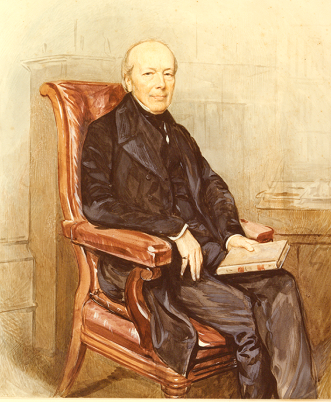
William Alers Hankey (original possibly by Lacretelle)
William Alers was the son of Thomas Hankey (1740-1793) and Maria Allers, and their only child. Thomas Hankey was never married to Miss Alers who, according to tradition, was a governess in the Hankey household; he was married ten years after William’s birth to Elizabeth Weaver, having by her three daughters before the marriage and two sons and a daughter after.
William was born in London on 15 Aug 1771 and was baptized on 29 Sep 1771 at Hanover Square, St George; the father’s name was given as Thomas and the mother’s as Maria Allers. Willam lived for some years at Mile End, Stepney, and as this is the district where the Allars/Allers/Alers are known to have lived, this is quite possibly where he was brought up.
The fact of William having the surname Alers indicates that he was brought up by his mother, although he was acknowledged by Thomas as his son and received a substantial legacy in his will. When William appeared before the Probate Court in 1829 in connection with the will of his step-mother Elizabeth Hankey, he confirmed that he had known her for the previous thirty years, that is from about the turn of the century when he was in his late twenties (although his duties as executor of his father’s will must have brought them into contact from 1793). Clearly he had not been brought up with Thomas Hankey’s other children, but became on intimate terms with many of the Hankey family, as their friend, partner or executor.
From 1787 to 1789 William attended the University of Edinburgh, and always referred, with pleasure, to the fact of his having there enjoyed the friendship of those eminent men, Dr. Robertson, the Principal, and Professors Dugald Stewart and Andrew Dalzel. He read humanities, Greek and logic, being destined, according to his grandson Henry, for a career in the Church. William’s abilities were recognised early, as in 1788, when not yet seventeen, he was named by his father as an executor of his will and a trustee for his other children.
His education being completed, in May 1789 William left the family of his tutor Mr Marshall in Edinburgh, and on 12 May 1789 took the mail coach from Alnwick to London – ‘a raw youth, in my 18th year, with the wide world before me, & utterly ignorant’ ‘in what part of the world, or in what position in life, my peregrenation, then begun, would end’.
He took up residence with Stephen Hall and his wife Mary, who lived at New Grove, Mile End, and it was they who then introduced him to the Independent church at Bull Lane, Stepney, which was to play such an important part in his life.
Stephen Hall had been for many years a partner in Hankey & Co, a long-established firm of bankers in Fenchurch Street. William preferred to go into the Bank rather than enter the Church, and a few months after arriving in London on 21 Dec 1789, the eighteen year-old William entered the firm, of which his father Thomas Hankey was then the senior partner. He and his cousin Augustus were ‘received into Fenchurch Street to work and make themselves useful until the time should come when they could coax Chaplin Hankey to let the Thomas Hankeys come in, in such force’.
William soon took a leading role in the conduct of the bank’s affairs, and by 1802 had become a partner. Augustus Robert Hankey became the senior partner in June 1815, following the death of his father Robert, and William evidently did not assume that role until Augustus’ death in 1830.
Stephen Hall’s ‘beautiful’ wife, Mary nee Grace, had brought up Mary Martin, an orphan. Mary Martin had been born in 1770 and her father, Samuel Martin of Bucklersbury, was a first cousin of Stephen Hall’s wife, whose mother was a Martin.
It was to Mary Martin that William Alers, also of Mile End, was married on 26 July 1797 at St Dunstan, Stepney, Stephen and Mary Hall being the witnesses.
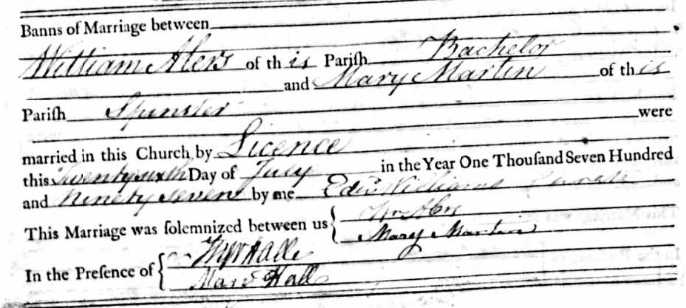
One of Mary Alers Hankey’s grand daughters wrote in 1903 that she ‘was a beautiful woman. I remember her, of course, in lovely satin gowns, and August caps. She was fond of French blonde lace, if you know what that is! My mother [Mary Hall Alers Hankey] had some in her trousseau, & [her] wedding dress was trimmed with it. You ought to see two exquisite miniatures of the pair, painted as it was done formerly, before Photography existed.’
William and Mary Alers first family home was in the Mile End Road close to Stephen Hall’s large house at New Grove, Mile End. They continued for several years to live at Mile End, but in about 1802 moved for a time to 5 Fenchurch Street, as was customarily expected of junior partners.
They had six sons and three daughters:
Mary Hall |
1798-1866 |
|
William Augustus |
1801-1803 |
Died of whooping cough |
1803-1872 |
|
|
William |
1804-1866 |
West India broker (bankrupt 1831). m 1852 Elizabeth Keeling.Died of typhoid at Archerfield House, Highbury New Park. SP |
1806-1872 |
|
|
1807-1888 |
|
|
1809-1878 |
|
|
1812-1887 |
|
|
1814-1902 |
|
On his death in August 1809, Stephen Hall, having no children of his own, left substantial legacies to his late wife’s cousins Mary Alers and her three sisters, and appointed William his executor and residuary legatee. It was on the strength of this useful inheritance that William was able, on 4 Nov 1810, to move with his family to a handsome and imposing mansion in Mare Street, Hackney, an area, like Stepney, much favoured by Protestant Dissenters. This had an extensive garden, lawns, a terrace walk and some fine old elm trees, together with entrance gates, a large yard and stabling. The site later became the Lady Holles Girls School.
Although much occupied, William was not content to limit his energies to the mere requirements of business, and at about the time of his marriage in 1797 began his lifetime’s involvement in the work of bible, tract and missionary societies. Gifted with a large share of natural abilities, in combination with great activity of mind, he was qualified for a successful pursuit of literary and scientific objects. And with these, especially within the range of biblical subjects, he always evinced considerable sympathy, not unfrequently contributing to one of the organs of periodical literature such as the Eclectic Review, of which he was editor. Indeed to the very close of his life, there was nothing that excited in him a deeper interest than a new reading of the Sacred Text, or a critical note on some passage of the Greek Testament.
But the full amount of his energies was thrown into efforts of various kinds to diffuse moral and religious principles. Hence, in 1801, he joined the Religious Tract Society, and for eight years assisted zealously in its proceedings. It is stated in a published history of the Society, that, on the preparation of some scripture extracts and tracts for the use of foreign prisoners of war, then in confinement, Mr. Hankey ‘made one novel and interesting contribution to the Society’s work. He mastered Spanish, that he might be duly qualified to revise the tracts in that language for the press, so as to insure their freedom from error.’
He also became one of the founders and conductors of the British and Foreign Bible Society; and was one of the last survivors of the group of excellent men who, in 1804, had publicly launched into existence that invaluable institution. So again, from 1801 to 1832, he actively identified himself with missionary enterprise, voluntarily combining with the office of Treasurer of The London Missionary Society, which he held from 1816 until his resignation in 1832, many of the duties usually devolving upon the Secretary.
William was a friend of Robert Humphrey Marten, who like himself was a non-conformist and greatly active in the fields of business, religion and philanthropy. Marten later wrote concerning the year 1811: ‘I subscribed £21 this year to the Lancastrian School system and served with Mr Alers Hankey as steward to a very numerous assembly at a dinner to promote it, at which the Dukes of Sussex, Kent & Bedford and Lord Keith with my friends Sir John Jackson & Mr Wm Allen the Treasurer were present.’ In 1813 RH Marten married WAH’s sister in law Emma Maria Martin as his third wife, and the events leading up to the marriage are recorded in RH Marten’s autobiography for the year 1813:
‘In consequence of the very high character I had heard of various friends of Miss Emma Martin, I requested by my friend Brown whose daughters were among her many pupils & whose judgement I greatly valued to introduce me at Colebrook Row to the acquaintance of that Lady & early in the present year I waited upon her Brother-in-law Mr Alers & obtained his & her permission to visit the family with the avowed intention of soliciting the hand which on the 8th July he honoured me by presenting to me at Islington Church; having her family & my eldest son to grace the union. I desire to record my gratitude for this benefit which a kind providence has vouchsafed to supply the loss which I and my family had sustained, and I have the happiness to know that not myself alone, but that every branch of my family, the church, & the neighbouring poor have all had reason to rejoice with me in the happy event of this day.’
William’s uncle and partner Robert Hankey died in June 1815, as a result of which, William wrote, ‘An event has arisen .... which I had not entertained a thought of - the taking of the name of Hankey in addition to my own name.’ Robert Hankey’s daughter Matilda Hartsinck wrote in 1839 that ‘the Alers branch ... has always been dearest to us. Not merely since I knew anything of the communion of saints, but for years before. ... I have always felt pleased and proud of my relationship & if as I think has been the case I have spoken oftener of affection & friendship to him & his & not of affection & kindred ties, it has been from an idea that it might bring to his mind a painful feeling as regarded our common relations, which might seem unnecessary to produce. But myself, my brother, my father & mother always looked upon dear Alers as one with us - and more one indeed than other Hankeys & my father was for years & years very anxious indeed that he should assume the name which you know at last was so happily & very properly brought to pass to the joy of every one of the family of Robert & I verily believe by the other branches, at least they all expressed themselves to that effect, Barnard most particularly so’.
William Alers closeness with his father’s family thus received especial recognition when on 16th December 1815 he received a Royal Licence to use the additional surname of Hankey and to use the Arms of Hankey only with proper distinctions.
William wrote in 1818 of the Hankeys, ‘the family to which I stand so nearly related .... there are in it those who are dear to me, but who alas are strangers to thy grace’.
In Jan 1816 he wrote that ‘as the winter approached I thought myself justified in adding to the comforts of myself & family by having a close carriage - May the Lord hide pride from my heart while he increases my enjoyments’. Robert Hankey had died in June 1815, and it is possible that William’s acquisition of a carriage was not unrelated to the availability of a parking space in the yard behind the bank.
Through his friendship with a neighbour in Hackney, William became an Associate of the Institution of Civil Engineers. His connection with the Institution dated from a very early period in its history. During his residence at Hackney, his immediate neighbour was the Father of Mr Henry Robinson Palmer, by whose intelligence and talent he was so much struck, that he interested himself much in his career, and introduced him to Mr Telford, whose favourite pupil he soon became. He still kept up the communication with his young friend; and when, towards the close of the year 1817, Messrs William Maudslay, Henry R. Palmer, Joshua Field, James Jones, Charles Collinge and James Ashwell, resolved to form themselves into a Scientific Society, - holding the first Meeting of the Institution of Civil Engineers on the 2nd of January, 1818, - William Alers Hankey encouraged them by every means in his power. In 1820, after the Institution had assumed a substantial form, he joined it as an Associate, becoming, subsequently, one of the earliest Honorary Members, and in the same year, he was elected Treasurer and Banker to the rising Society. This position he held until 1845, when, for the convenience of the Society, the funds were transferred to a West End bank, and the Council instructed ‘the Secretary to convey, in an appropriate manner, to Messrs Hankey and Co., the thanks of the Council for the uniform attention shown by them to the interests of the Institution, and to Mr. William Alers Hankey personally, for having so many years filled the office of Treasurer.’
These few details serve to demonstrate the leading features of William Alers Hankey’s character. With the good of his fellow-creatures much at heart, he was ever ready, by means of his purse, or his influence, to further any well-considered plans of Christian benevolence. But persuaded, that the spread of religious knowledge, with a view to the extension of religious principles, should be the high aim of the Christian philanthropist, he specially devoted himself to these objects; and during a long life, laboured for them with a perseverance, a singleness of purpose, and a self-denial rarely equalled.
When the lease of his house in Hackney expired in 1828, William Alers Hankey bought a 14-year lease on a property in Walthamstow, a favourite retreat of wealthy London non-conformists, and here in 1831 he had eight domestic staff. His daughter Sarah Sewell wrote in 1886 that ‘once on Sunday there was a morning drive, with GF always, to Stepney, or for the Sacrament in the afternoon. Latterly GM did not like the fatigue & I used to accompany GF solus till the Marsh damps were pronounced the cause of my flagging. Walthamstow broke up after Torquay & Connaught Place West (each a winter) for 5 Hyde Park Gardens.’ William left Walthamstow in April 1842, and at about the same time retired from active management of Hankey & Co. He wrote that the recurring illness of his wife and daughters ‘after various temporary changes, has led to my settlement [in 1843], under medical advice & recommendation, in a part of the Metropolis which I never contemplated, & was even far from desiring - But by one slip after another, I have been led to settle my family for a time .... in the house in which I am now writing - in Hyde Park Gardens’ – ‘a house of a somewhat higher class in point of style than I should have sought for’. He remained there until his death sixteen years later.
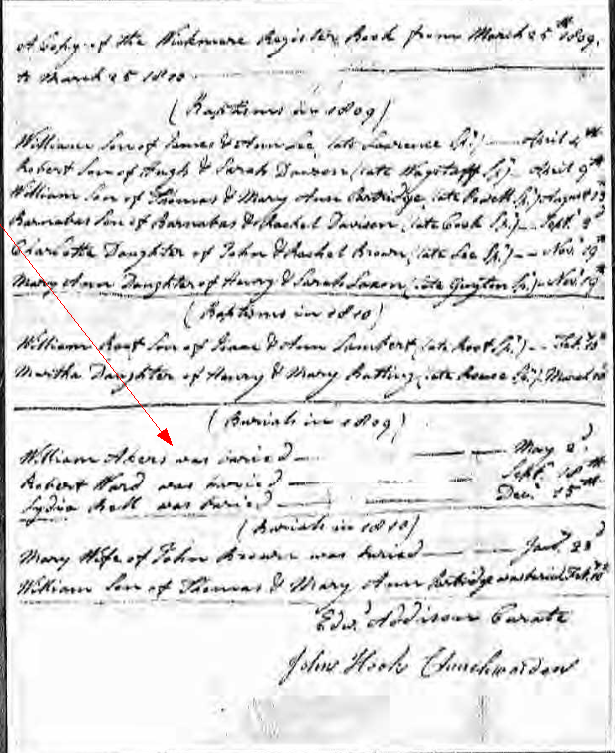
William’s personal contacts seem to have been of a severe nature, and he ruled both his family and the bank with a rod of iron. It was said that the clerks at the bank dared not even cough in his presence for fear of instant dismissal, and they never had colds. William’s daughters called him ‘Mr Papa’, and a tale was told that all the greeting he had on being first introduced to his grandson John’s sweet young fiancée was ‘I hope she will be worthy of my esteem’ - this as he eyed her severely. When his daughter protested with ‘Oh Mr Papa, try to say something more pretty to John’s future wife’ his only rejoinder was ‘I think that is a great deal to say’. ‘In his family he seems to have met with something of the general fate of tyrants, as they found it necessary to exercise deceptions of innocent enough kinds, for the sake of peace for him as well as for themselves’. One of his grand daughters wrote ‘our generation held the Grandfather in great awe, and the Christmas dinner party, at which uncle Tom’s family and ourselves were usually the guests, was a ‘fearful joy’ if a joy at all, mitigated by Christmas boxes!
His Religion
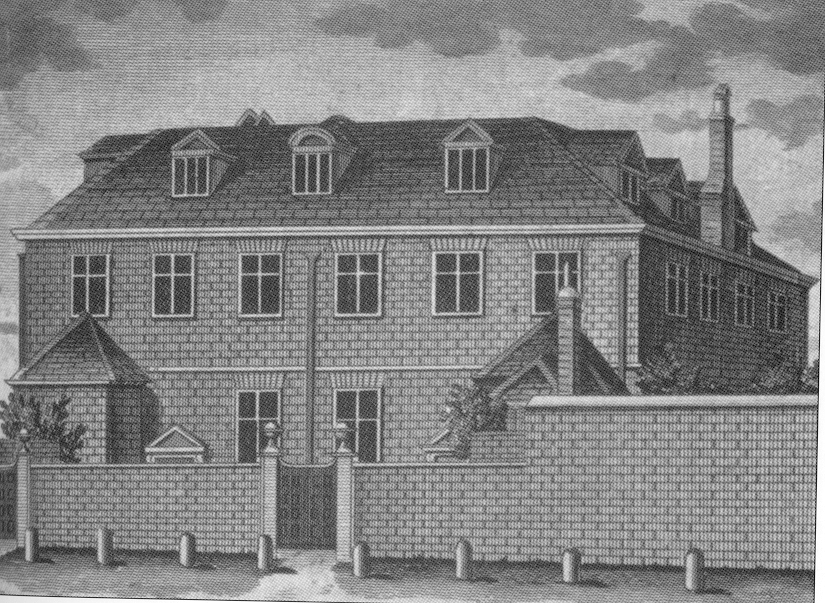
The Dissenters Meeting House at Bull Lane, Stepney
Religion played a highly important part in the life of William Alers Hankey. His religious views seem to have been divided between Church and Chapel, though strongly inclining to the latter. He was a member of the Independent or Dissenting Protestant church, as were his wife and her family, the Martins. All their children were baptised (between 1798 and 1814) at the Independent chapel at Bull Lane, Stepney, and most of their grandchildren, up to 1836, at the Kings Weigh House Independent chapel at Fish Street Hill.
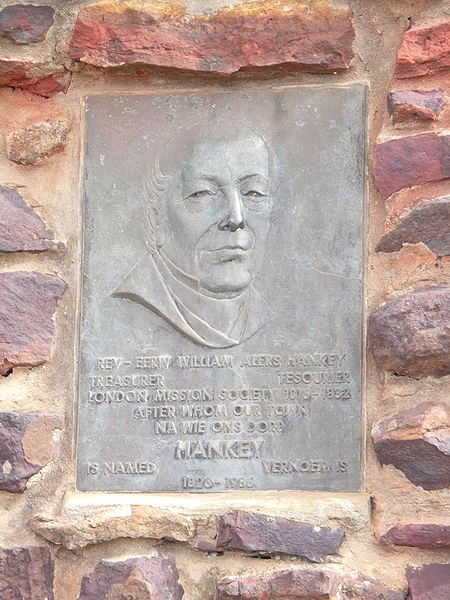
Engraving of William Alers Hankey in the town named after him.
Image source: Wikipedia
Neither Thomas Hankey nor any earlier Hankeys were Dissenters, although Sir John Barnard’s parents were both Quakers. It is possible that William obtained at least some of his religious inspiration from John Marshall, his tutor at Edinburgh, and in 1787 he was received into communion in the Burgher Secession Church in Alnwick and Edinburgh. After completing his studies at Edinburgh in 1789, he took up residence with Stephen Hall and his wife Mary nee Grace, who had long been members of the Dissenting church at Bull Lane, Stepney. It was through the Halls that in the middle of May 1789 William first attended the Stepney Meeting. In March 1792 he became a Member, under the pastoral care of Rev Samuel Brewer, and on 16 Oct 1800 was chosen a Deacon in that Church. He wrote later that ‘it was a peculiar dispensation of providence which in my youth brought me into connexion with a Christian family, long in membership with the Church at Stepney, & out of which the most important & interesting events of my life have arisen.’
William was actively associated with projects under the auspices of the ‘Clapham Sect’, a group of philanthropic Evangelical churchmen, mostly wealthy businessmen, who had their mansions at Clapham. It is tempting to think that Sir John Barnard or Sir Thomas Hankey, who both lived at Clapham, were associated with the Clapham Sect; both had died fifteen years or more before it was founded in 1785, but one of their friends was Rev Henry Venn, Curate of Clapham 1754-59, whose son Rev John Venn played a prominent part in the affairs of the Clapham Sect and was one of the founders of the Church Missionary Society in 1797.
One of the greatest achievements of the Clapham Sect was in the work which led to the abolition of the slave trade. Their other main interests were missions; social and philanthropic movements; and bible and tract societies, and it was in missionary and bible work that William Alers became involved from the early years of the nineteenth century. He assisted in the proceedings of the Religious Tract Society from 1801 to 1808, and was one of the founders and conductors of the British and Foreign Bible Society in 1804. In 1801 he became a director of the undenominational London Missionary Society, and was its treasurer from 1816 to 1832, resigning after criticism of his role in the ownership of plantations; he contributed £100 annually to its funds. In 1823 the LMS founded a mission station in the Eastern Cape, now a substantial town, which was named Hankey after him; similarly, there is or was an Alers Plains in the south-east of Bechuanaland.
The Hankeys as West India Merchants and Plantation Owners
Samuel Hankey, together with John Houblon, had been engaged in trade with the West Indies as early as 1674. This trade was further developed by his nephew Henry Hankey, who in 1713 was introduced by the Dutch mercantile house Fizzeaux & Co to Peter Simond, a Huguenot of Dutch origin who also became established as a merchant trading with the West Indies. Over the next fifty years the Hankeys continued to develop similar interests in the West Indies, which were quite extensive by the middle of the eighteenth century.
Apart from their role as merchants in sugar and rum, an important part of the Hankey’s business was the provision of loans to plantation proprietors for the finance of working capital, secured by mortgage against the estate. Records from Spanish Town, then the capital of Jamaica, show three mortgages in the name of Hankey dated 1754. In 1766, for instance, five partners in Hankey & Co provided a loan of £15,000 secured by a mortgage on the Union sugar plantation in Grenada. By 1767 the partners had become one of the legal owners of the plantation due to a default in the mortgage payment and in 1772 the plantation was sold by trustees with the consent of the bank. Records indicate the plantation included 103 slaves in 1766 and 127 slaves in 1772.
It was agreed in 1764 that John Hankey, the second of Sir Thomas Hankey’s three sons, should go into partnership with Peter Simond and merge the West Indian side of the Hankey firm, and that on Peter Simonds death his business should pass to the Hankey family. The partnership of Simond & Hankey thrived and the firm soon had three ships sailing the Atlantic, as well as interests in other ships connected with Colonial trade. In 1777 Simond & Hankey are recordrd as owners of the privateer Simond, 300 tons, and this ship was later engaged in whaling. Simond & Hankey are also on record as having properties and mortgages in Grenada, Jamaica and Antigua, and as having acted on behalf of those willing to lend money on mortgages in these islands.
Apart from their interests in West Indian trade, several of the Hankey family were owners of plantations there:
-Joseph Chaplin Hankey (1727-1773) was married to Catherine Gale, who had been brought up in Jamaica where her parents owned sugar plantations, and the latter are said to have passed into the Hankey family.
-John Hankey (1741-1792) owned a 1/8th interest in Grand Bras Estates, Grenada which his son Thomson Hankey (1773-1857) subsequently increased to 5/8ths.
-William Alers Hankey together with his partners Augustus Robert Hankey (1768-1830) and Thomas Hankey (1791-1879) were proprietors of the Arcadia estate in Jamaica.
-Jameson Alers Hankey (1836-1917) was married to Minna Louisa Lyons (1841-1926). The Lyons family were prominent in Antigua from the seventeenth century. They owned substantial sugar plantations there, and had married into other land-owning families on the island.
The Arcadia Estate
Arcadia, situated in the parish of Trelawney on the north coast of Jamaica, was a plantation consisting of 1401 acres of cane, pasture etc. It seems that individual partners in Hankey & Co became part-owners from the 1790s by foreclosing on a mortgage.
William Barnett was proprietor of the Arcadia estate in 1802 (possibly having succeeded his father Hon William Barnett, 1733-1787) and John Clinton McAnuff was his agent there. William Barnett (Chief Judge of the Court of Common Pleas in Jamaica) and his wife Miss Markham (daughter of the Archbishop of York) had left Jamaica ‘lately’. In 1825 Augustus Robert Hankey, William Alers Hankey and Thomas Hankey purchased four slaves from Rev Samuel Smith and his wife Anne Brady Smith nee Barnett, sister of William Barnett.
In 1827 Arcadia was still in possession of William Barnett, but his agent JC McAnuff had died since 1825. In that year Messrs Hankey purchased seven slaves from Melchior Graham (of co. Cork, d 1832), heir of the late JC McAnuff, of Spanish Town, and a further ten slaves from Melchior Graham, brother and heir of the late Thomas Graham. Between 1825 and 1829, Augustus Robert Hankey, William Alers Hankey and Thomas Hankey are known to have purchased 22 slaves for £2,239. Hankey & Co., the banking firm of William Alers Hankey, which he had been careful to distinguish from his family’s West India merchant firm in his testimony to the Extinction of Slavery Committee in 1832, was awarded £5,777 8s 0d for slaves on Arcadia in Trelawney, and lodged a counter-claim as mortgagee against Sir Edward Hyde East on his estates in St Mary and elsewhere.
Sir Edward Hyde East, who had been born in Jamaica in 1764, was married to William Alers Hankey’s second cousin Jane Isabella Hankey.
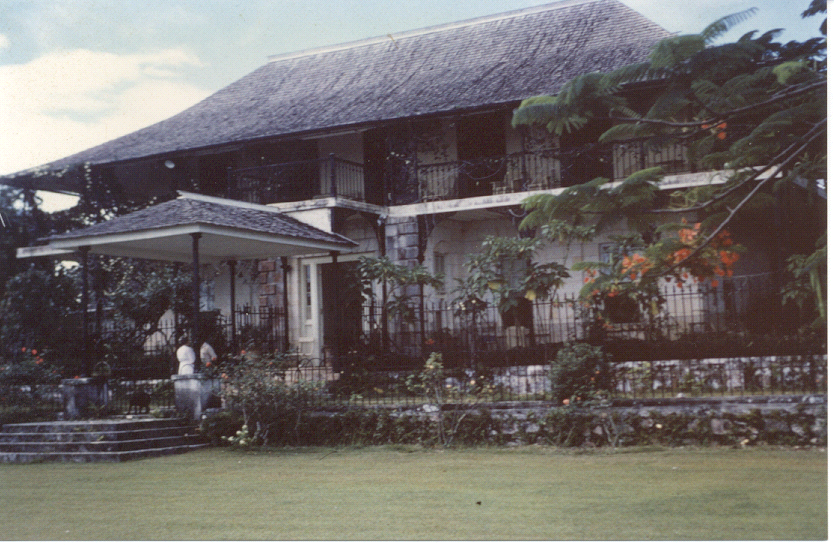
Arcadia, 1961
Augustus Robert Hankey died in 1830 and WAH exercised an option to purchase his share in Arcadia and other lands in Jamaica for £5000. A bungalow was built at Arcadia in 1832, that with an additional storey is now the Great House, and that date is said to be chiselled on the keystone arch of the front door.
Early in 1832 Jamaica was rocked by a slave rebellion, the blame for which the planters firmly placed at the door of the non-conformist missionaries. As an absentee proprietor, William Alers Hankey found himself in the centre of a controversy when charges of failing to show a modicum of Christian charity towards his slaves were brought against him in the Anti-Slavery Reporter. He was in effect a victim of circumstances and was probably singled out for this attack because of the cruel and deceitful behaviour of his attorney, one William Miller. This episode led in 1832 to his resignation as Treasurer of the London Missionary Society.
In 1833 WAH gave evidence on slavery before the House of Commons. He reported that Arcadia contained about 300 slaves. He also reported that he had made loans to two other Jamaican plantations, the New Hope and Albany estates.
In 1838 William Alers Hankey’s record at Arcadia was again savagely attacked by Sturge and Harvey in their book The West Indies in 1837. WAH was prompted to a spirited defence against this highly partisan diatribe in his Letters to Joseph Sturge relating to the Arcadia Estate in Jamaica. He was one of the first owners to give his slaves their freedom, in August 1838. Paul King, for many years book-keeper and overseer at Arcadia, was by 1838 also part Attorney. He was still the agent in 1850. WAH died in 1859, and in 1866 Arcadia was sold by his heirs to William Sewell.
Arcadia Mountain, in Trelawney, was sold in 1954 by the Commonwealth Missionary Society to the Kaiser Bauxite Co.
Charlotte Alers Hankey wrote a Doggerel History of England for her children, and for the year 1833 wrote:’Hankey’s free sugar was the first sold In London Market so I’ve been told.’
William was a second cousin of 3rd Viscount Palmerston, Prime Minister 1855-58 and 1859-65. In 1788 his father Thomas Hankey had been godfather to Lord Palmerston’s younger brother William.
Mary Alers Hankey died on 23 Jan 1851, aged 80, and was buried on 30 Jan at Abney Park Cemetery. William closed his mortal career at his house at 5, Hyde Park Gardens, on the 23rd March, 1859, in the 88th year of his age, wearied with bodily infirmities, but, in his own words, ‘with the mind at peace’; he was buried on 28 Mar at Abney Park Cemetery (square 63).
His will, made on 22 Jul 1852 and witnessed by his lawyer Alexander Devas Druce of Billiter Square, was proved on 18 Apr 1859 at London, under £250,000 (approx £14million in 2005's)
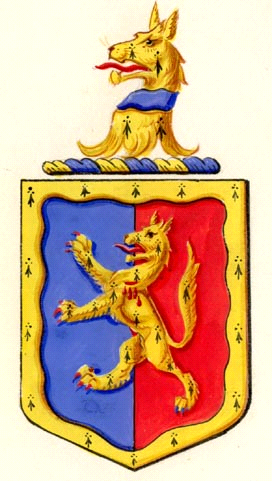
Addresses:
1797, 1803 Mile End, Stepney 5, Fenchurch Street
1810-1828 Mare Street, Hackney
1828-1842 Walthamstow
1842-1843 Connaught Place West
1843-1859 5, Hyde Park Gardens
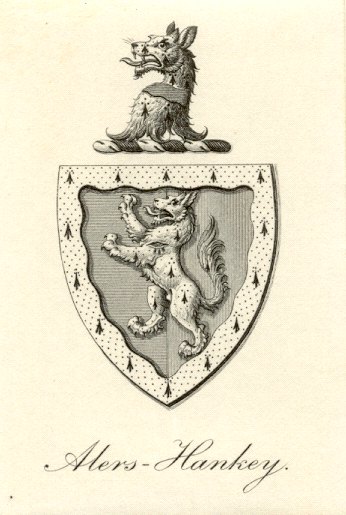
Crest: A wolfs head erased at the neck erminois gorged with a collar wavy azure
Arms: Per pale azure and gules, a wolf salient erminois vulned on the shoulder of the second, a bordure wavy of the third
STEPHEN HALL (1727-1809)
Born in 1727, Stephen Hall was a partner of the bankers Hankey & Co. of Fenchurch Street, from 1765 until his death in 1809. He had been a witness to Sir Joseph Hankey’s will in 1762. He and George Garthorne (d 16 May 1800) were the only persons from outside the family admitted to partnership. In 1802 the firm was styled Hankey, Hall, Hankey and Alers.
Stephen Hall lived from 1778/79 and for many years afterwards on the south side of Mile End Road at New Grove, where his house had a library whose inventory survives. His Land Tax was based on a rack rent of £100, indicating a substantial property and one of the largest in the area; in 1790 he had one male servant. He also lived at one time above the bank in Fenchurch Street.
Stephen Hall was married by licence dated 10 Feb 1764 at Bromley, St Leonard, to Mary Grace, daughter of John and Mary Grace of Bromley, Mx. Witnesses John Grace and Valentine Hall. Baptised on 4 Feb 1733 at Stepney, Bull Lane Ind., Mary died on 12 May 1809, aged 76, being carried from Fenchurch Street on 19 May 1809, to be buried the same day in the family vault in the churchyard at Foots Cray. They are not known to have had any children.
Stephen Hall died on 14 Aug 1809, aged 82, and was carried from Fenchurch Street to be buried on 21 Aug 1809 at Foots Cray. His will, made on 24 May 1809 and proved on 28 Aug 1809 in London, is a valuable source of information. He gave a number of substantial legacies to:
-Valentine Adshead (a ‘relation’) and his three sisters (one of whom was Mary, wife of Thomas Smith).
William Alers Hankey recorded that Valentine Adshead died on 22 May 1815, and that ‘he was left under my care by Mr Hall. He had been a Lunatic & afflicted with fits of the Epileptic kind for 20 years, & was a great part of that time under the care of Mr Warburton at Hoxton’. Valentine Adshead, son of Henry and Martha, was baptized on 25 Dec 1766 at Macclesfield. [A Henry Adshead married Hannah Hall of Rushbury, Cheshire on 10 Mar 1747 at St Benet, Pauls Wharf.]
-Rebecca Biss, widow, of Braintree.
-Mrs Sarah Day of Richmond (Mary Hall’s niece, daughter of Richard Morson and wife of James Day). She died in 1850, having left property to William Alers Hankey, whose wife was her second cousin.
-Mrs Susannah Sharp of Romsey (Mary Hall’s niece, daughter of Richard Grace and wife of William Sharp), with her children Susanna, William and Stephen.
-Elizabeth Rebecca Martin (later the wife of Joseph Procter) and her sister Emma Maria Martin [later the wife of Robert Giles Marten]; Mary Alers (wife of William Alers, later Alers Hankey) and her sister Sarah Martin. Emma Maria, daughter of Samuel and Elizabeth Martin of Bucklersbury, was baptised on 4 Dec 1768 at Bishopsgate, Hand Alley Independent. The Martin sisters were first cousins once removed of Stephen Hall’s wife Mary.
William Alers married Mary Martin by license on 26 Jul 1797 at St Dunstan, Stepney in the presence of Stephen Hall and Mary Hall; their first child was named Mary Hall Alers. Mary Martin had been brought up by Stephen and Mary Hall.
An important connecting link between these families is their membership of the Independent or Dissenting church. The Hall, Grace, Martin and Alers families were all members of the Meeting House at Stepney; the Sharps and the Days were also Dissenters.
William Alers came to live in Stephen Hall’s house on leaving university in 1789, becoming his very close friend, and having the strong common bond of religion and membership of the Stepney Meeting. Stephen Hall had been a partner of William’s grandfather Sir Thomas Hankey as early as 1765, of his father Thomas Hankey, and from 1802 of William himself; he was a witness at William’s marriage in 1797, and his wife was a relation of William’s wife, Mary Martin. Finally, he appointed William Alers his executor in 1809 and his residuary legatee.
HABERDASHERS COMPANY
Apprentice Bindings
July 1657
Samuell Hanky, son of Robert Hanky of Darnall in the County of Chester, gent, bound to Thomas Bigge, Citizen & Haberdasher of London for 7 years from the date dated as above.
March 1683
Henry Hanky, son of Thomas Hankey of Newchurch in the County of Chester, Yeoman, bound to Samuell Hanky, Citizen & Haberdasher of London for 7 years from the date dated March 23rd.
Admissions
29 Jul 1664 Samuel Hankey (Thomas Bigge)
4 Apr 1690 Henry Hankey (Samuel Hankey) Master 1728
20 Feb 1702 John Hankey (Henry Hankey)
20 Sep 1728 Joseph Hankey (patrimony) Master 1737
25 Oct 1728 Thomas Hankey (patrimony) Master 1745
KNIGHTS BACHELORS
28 Sep 1732 Henry Hankey, sheriff of London
28 Sep 1732 John Barnard, alderman of London
4 Aug 1737 Joseph Hankey, alderman of London (at Hampton Court, on the presentation of an address congratulating the King on the birth of a princess to Her Royal Highness the Princess of Wales, from the lord mayor and Court of Aldermen of the City of London)
21 Feb 1744 James Creed [husband of Thomas Hankeys sister Mary]
9 Sep 1745 Thomas Hankey, of London, a banker, a commissioner of lieutenancy for the City of London
18 May 1803 Richard Hankey, as proxy for Sir Andrew Mitchell
18 Nov 1818 Colonel Frederick Hankey, secretary to the High Commissioner of the Ionian Islands. Invested KCMG at Corfu
1The same day as Sir Walter Scott
2The Times, 27 Jul 1797: Yesterday Mr Alers, of Mile End, to Miss Mary Martin, of the same place.
3Marten papers, Cambridge University Library